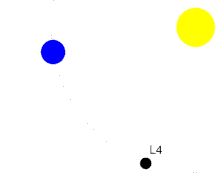Theia (protoplanet)
Theia is a hypothetical protoplanet that collided with the earth about 4.5 billion years ago according to the collision theory of the formation of the moon . Theia herself was destroyed in this collision. The fragments created by the impact gathered in an orbit around the earth . In the further course the moon formed from it. According to this theory , Theia was about the size of Mars . According to one of these models, Theia had formed at the Lagrangian point L 4 of the earth-sun system. It followed Earth for a long time as a " Trojan " before the collision occurred.
Surname
The name Theia for the hypothetical impactor was first used in a paper from 2000 (AN Halliday) and comes from Greek mythology . According to this myth, the moon goddess Selene was born by the titan Theia .
Emergence
From a comparison of the isotopes in the rocks of the earth and the moon , it could be deduced that most of the material from which the moon was formed comes from the mantle of the proto-earth. The Theias material apparently did not cause any change in the isotopic composition of the Proto-Earth. This fact can be interpreted in different ways:
- Theia arose at the same distance from the sun as the proto-earth, and because of the great proximity to the sun, Theia was also composed for the most part of silicates , or
- Theia consisted mostly of ice.
The theory, according to which Theia originated in the Lagrangian point L 4 of the earth-sun system, speaks for the former possibility. Recent simulations that incorporate the chaotic effects of movement near Lagrangian points show that a body that forms in L 4 can actually reach the speed necessary to create the moon.
The result of a study completed in 2014, in which the frequency of certain oxygen isotopes in lunar rocks was analyzed and for the first time a difference in the oxygen isotope compared to the earth's rock was determined, is interpreted as an indication of the moon formation from a collision of the earth with a large asteroid . The results of the investigation should also indicate that Theias chemical composition was similar to that of the meteorite group of chondrites ( enstatite chondrites or carbonaceous chondrites ).
According to Gerrit Budde, Christoph Burkhardt and Thorsten Kleine, the isotope ratio of the earth's molybdenum can be used to prove that Theia came from the outer solar system and thus also brought a large part of the water to earth. So far, the high water content of the earth was difficult to explain (see also the origin of earthly water ).
See also
- Origin section in the article Solar System
- List of hypothetical celestial bodies in the solar system
literature
- Carsten Münker, Jörg A. Pfänder, Stefan Weyer, Anette Büchl, Thorsten Kleine, Klaus Mezger: Evolution of planetary cores and the Earth-Moon system from Nb / Ta systematics. In: Science 301, 2003, ISSN 1095-9203 , pp. 84-87.
- Ulrich Wiechert et al .: Oxygen Isotopes and the Moon-Forming Giant Impact. In: Science 294, 2001, ISSN 1095-9203 , pp. 345-348.
- AN Halliday: Terrestrial Accretion Rates and the Origin of the Moon. In: Earth and Planetary Science Letters 176, 2000, ISSN 0012-821X , pp. 17-30.
- K. Pahlevan and DJ Stevenson: The Oxygen Isotope Similarity of the Earth and Moon: Source Region or Formation Process? In: Proceedings of the 36th Annual Lunar and Planetary Science Conference, March 14-18, 2005, in League City, Texas No. 2382, 2005.
- Robin M. Canup: Simulations of a late lunar-forming impact . In: Icarus . tape 168 , no. 2 , April 2004, p. 433-456 , doi : 10.1016 / j.icarus.2003.09.028 .
Web links
- Oxygen isotopes in the early solar system
- The birth of the moon (Mineralogical Institute of the University of Munich and Max Planck Institute for Chemistry)
- Origin of the moon (with animations)
- Report on simulations with different parameters for Theia (PDF file; 2.01 MB)
Individual evidence
- ^ A b E. Belbruno, R. Gott III: Where did the moon come from? In: The Astronomical Journal 129/2005, ISSN 0004-6256 , pp. 1724-1745.
- ↑ Junjun Zhang, Nicolas Dauphas, Andrew M. Davis, Ingo Leya, Alexei Fedkin: The proto-Earth as a significant source of lunar material . In: Nature Geoscience . tape 5 , no. 4 , April 2012, p. 251-255 , doi : 10.1038 / ngeo1429 .
- ↑ Where does the moon come from? faz.de. June 5, 2014, accessed June 7, 2014.
- ↑ Isotope analysis supports impact theory. ( Memento of the original from June 19, 2014 in the Internet Archive ) Info: The archive link was inserted automatically and has not yet been checked. Please check the original and archive link according to the instructions and then remove this notice. stellariumblog.blog.de , June 7, 2014, accessed June 7, 2014.
- ↑ Daniel Herwartz, Andreas Pack, Bjarne Friedrichs, Addi Bischoff: Identification of the giant impactor Theia in lunar rocks . In: Science. 344, No. 6188, 2014, pp. 1146–1150, doi: 10.1126 / science.1251117 .
- ↑ Gerrit Budde, Christoph Burkhardt, Thorsten Kleine (2019): Molybdenum isotopic evidence for the late accretion of outer Solar System material to Earth . in Nature Astronomy , doi: 10.1038 / s41550-019-0779-y

